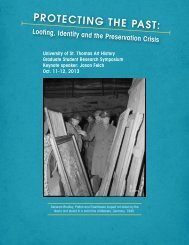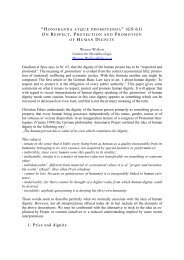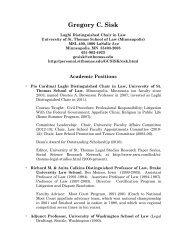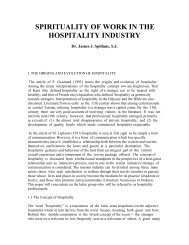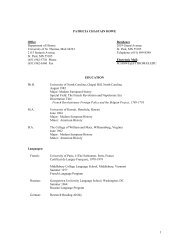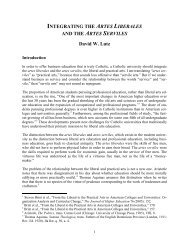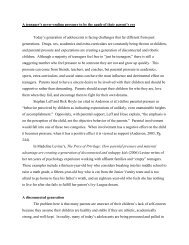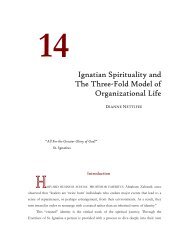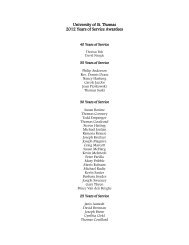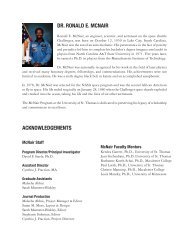McNair Research Journal - University of St. Thomas
McNair Research Journal - University of St. Thomas
McNair Research Journal - University of St. Thomas
Create successful ePaper yourself
Turn your PDF publications into a flip-book with our unique Google optimized e-Paper software.
Humanities & Social Sciences<br />
Trauma and Resilience:<br />
What we can learn from Naruto<br />
Mai Cha Vang & Jean Giebenhain, PhD<br />
<strong>University</strong> <strong>of</strong> <strong>St</strong>. <strong>Thomas</strong> - Department <strong>of</strong> Psychology<br />
This study examines trauma and resiliency in the Naruto graphic<br />
novel/manga series. The characters Naruto (hero) and Gaara (villain) are<br />
examined using the framework <strong>of</strong> the Search Institute’s 40 Developmental<br />
Assets. This study investigates the developmental assets that contribute to<br />
Naruto’s resilience, as well as factors that could contribute to Gaara’s negative<br />
trajectory. Suggestions for using “Naruto” in a therapeutic context are also<br />
discussed.<br />
Key words: trauma, resiliency, Naruto, manga, fiction<br />
Introduction<br />
Impact <strong>of</strong> Trauma<br />
Trauma can happen at any time in any stage <strong>of</strong> life. It can shake the<br />
foundation <strong>of</strong> any person’s beliefs about safety and their basic level <strong>of</strong> trust<br />
(Baldwin, 2008). For a child that is still learning to understand the world,<br />
a single traumatic experience may affect personality development and<br />
contribute to psychological disturbances. Chronic and severe maltreatment<br />
have even greater consequences on the child’s psychology because<br />
trauma has a direct impact on neurological development (Weitzman,<br />
2005). Up to 81% <strong>of</strong> men and women in psychiatric hospitals diagnosed<br />
with a major mental illness have experienced physical and/or sexual abuse<br />
with 67% <strong>of</strong> them exposed to prior childhood abuse (Hodas, 2006).<br />
Childhood trauma is especially important because it directly impacts the<br />
foundation <strong>of</strong> the developing brain and the child’s beliefs and perception<br />
<strong>of</strong> the world. Childhood trauma, in addition to physical, sexual, and<br />
verbal abuse, includes spurning, terrorizing, rejecting, and isolation<br />
(Kairys et al., 2002). It can also involve anything that could cause the<br />
child to feel worthless, endangered, or as if his/her only value in life lies in<br />
meeting someone else’s needs (Murray, 2008). How the child responds to<br />
such experiences depends on the type <strong>of</strong> trauma, age, gender, chronicity<br />
and severity <strong>of</strong> the event, and family interaction (Kairys et al., 2002;<br />
Weitzman, 2005). Therefore, a child’s adjustment to life will be deeply<br />
influenced by what follows the traumatic event (e.g., additional trauma or<br />
social support; Muller et al., 2008).<br />
<strong>Research</strong> has found that a child’s adjustment is influenced by many factors<br />
(Hodas 2006). These include characteristics related to the individual<br />
child—age, past exposure to trauma, presence <strong>of</strong> pre-existing social<br />
support; characteristics related to trauma exposure—proximity <strong>of</strong> the<br />
trauma, specific type <strong>of</strong> trauma, gender, relationship to the perpetrator,<br />
severity, duration and frequency <strong>of</strong> trauma, chronicity <strong>of</strong> trauma; along<br />
with post traumatic factors such as early intervention and societal support<br />
and response. Hodas (2006) also found that the younger the child’s age<br />
when the trauma occurs, the more pr<strong>of</strong>ound the effect. Following the<br />
abuse, those who view themselves and others more positively have higher<br />
levels <strong>of</strong> perceived support than those who view themselves and others<br />
more negatively (Muller et al., 2008; Brassard & Riverlis, 2006).<br />
Both pre and post-trauma factors influence the child’s adjustment to<br />
trauma. To help decrease negative effects <strong>of</strong> childhood trauma, psychology<br />
must find ways to help these children cope. What are the factors that can<br />
help children when facing trauma?<br />
Search Institute: Developmental Assets<br />
The Search Institute, a non-pr<strong>of</strong>it organization, has studied more than 2.2<br />
million children and adolescents in their investigations to determine what<br />
Mai Cha Vang<br />
Trauma and Resilience<br />
factors promote resiliency. Their extensive research has led to a framework<br />
consisting <strong>of</strong> 40 developmental assets, which are associated with positive<br />
outcomes for children and teens. This framework <strong>of</strong> 40 Developmental<br />
Assets is broadly separated into 20 External and 20 Internal assets, listed<br />
within eight broad categories. External Assets include: Support, Empowerment,<br />
Boundaries and Expectation, and Constructive Use <strong>of</strong> Time. Internal<br />
Assets are divided into: Commitment to Learning, Positive Values, Social<br />
Competencies, and Positive Identity. Results from comprehensive research<br />
by the Search Institute have repeatedly shown a strong positive correlation<br />
between the number <strong>of</strong> assets a child possesses and promotion <strong>of</strong> positive<br />
behaviors and attitudes (e.g. students who have 31 or more assets have a<br />
40% greater chance to do academically better in school than students with<br />
10 or fewer assets; Search Institute).<br />
Descriptions <strong>of</strong> the Assets and Supportive <strong>Research</strong><br />
External Assets:<br />
1. Support Assets: Family Support, positive family communication, other<br />
adult relationships, caring neighborhood, caring school climate, and parent<br />
involvement in schooling.<br />
To have these assets, a child must be loved, affirmed, and accepted for<br />
who she/he is. Previous studies have shown support from adults in the<br />
neighborhood can reduce exposure to violence (Levine & Rosich, 1996;<br />
Melton, 1992; Sampson et al., 1997). Adult support has also been<br />
correlated with greater self-esteem, hopes for the future, and cheerfulness<br />
(Talmi & Harter, 1998), and can lead to more pro-social behavior and<br />
fewer behavior problems for the child (Cochran & Bo, 1989). <strong>Research</strong><br />
also supports the importance <strong>of</strong> bonding between a parent and child to<br />
promote resilience: youth whose parents show love and care toward them<br />
are less likely to be involved in violence (Aspy et. al, 2004).<br />
2. Empowerment: Community values children, children as resources, services<br />
to other, and safety.<br />
Overall, empowerment is conceptualized as 1) “how safe a youth feels and<br />
what kind <strong>of</strong> role the youth feels he or she is in making the community a<br />
better place”, and 2) “how a young person perceives the adults’ view <strong>of</strong><br />
youth generally” (p. 51; Scales & Leffert, 2004). <strong>St</strong>udies in this category<br />
have shown that when youth feel valued in the community they live in,<br />
they are more likely to approach self-actualization (Karnes et al., 1993),<br />
have a higher level <strong>of</strong> moral reasoning (Bernard, 1990) and reduced<br />
delinquency (Bilchik, 1995: Linquanti, 1992; Coordinating Council on<br />
Juvenile and Delinquency Prevention, 1996). Getting involved as a<br />
community volunteer has also been found to decrease the likelihood <strong>of</strong><br />
risk-taking behaviors, such as carrying a weapon or the likelihood <strong>of</strong> never<br />
have been arrested (Rodine et al., 2006).<br />
3. Boundaries and expectations: Family boundaries, school boundaries,<br />
neighborhood boundaries, adult role models, positive peer influence, and high<br />
expectations.<br />
To navigate through life, a person usually needs boundaries and expectations<br />
to serve as guidelines. Boundaries and expectations are “rules, standards<br />
and norms pertaining to behavior” (p. 75,;Scales & Leffert, 2004)<br />
dependent on the context. Boundaries and expectations are set either<br />
through clear rules from family about certain things a child can or cannot<br />
do, or they are also set by adults and peers who model responsible and<br />
positive behaviors and expect the person to be the best they can be.<br />
<strong>Research</strong> has shown that having positive adult role models is associated with<br />
52 <strong>University</strong> <strong>of</strong> <strong>St</strong>. <strong>Thomas</strong> <strong>McNair</strong> <strong>Research</strong> <strong>Journal</strong>



